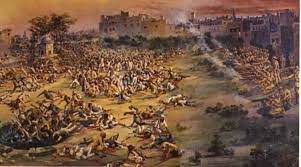CURRENT AFFAIRS
Get the most updated and recent current affair content on Padhaikaro.com
Rowlatt Act & Jallianwala Bagh Massacre
- IAS NEXT, Lucknow
- 24, Nov 2022

Rowlatt Act & Jallianwala Bagh Massacre|
Rowlatt Satyagraha was in response to the British government enacting the Anarchical and Revolutionary Crimes Act of 1919, popularly known as the Rowlatt Act. Gandhiji called for a countrywide campaign against the Rowlatt Act.
Rowlatt Act
This act was passed on the recommendations of Sedition Committee chaired by Sir Sidney Rowlatt.
This act had been hurriedly passed in the Imperial Legislative Council despite the united opposition of the Indian members.
This Act was termed the ‘Black Act’ by the Indian public because of its unjust and restrictive nature.
The Act was passed by the Imperial Legislative Council on 18th March 1919. It basically extended the emergency provisions imposed by the 1915 Defence of India Act that was passed during the First World War.
The Act gave the government the power to imprison any person suspected of terrorist activities for a maximum period of two years without trial.
It also provided for preventive indefinite detention and also arrest without a warrant. Other provisions were juryless trials for forbidden political acts.
Convicted people were to deposit securities upon their release and also refrain from taking part in any political, religious or educational activities.
The Rowlatt Act also severely curbed the freedom of the press.
All the Indian members of the Imperial Legislative Council opposed the bill. Despite this, the bill was passed.
This Act which gave the police huge powers was opposed by the people. The Act was described as “No Dalil, No Vakil, No Appeal”.
Impact Of World War I On India
Response to Gandhi's Call Mahatma Gandhi wanted non-violent civil disobedience against such unjust laws, which would start with a hartal on 6 April 1919.
But before it could be launched, there were large-scale violent, anti-British demonstrations in Calcutta, Bombay, Delhi, Ahmedabad, etc.
Especially in Punjab, the situation became explosive due to wartime repression, forcible recruitments, and ravages of disease.
In towns across North and West India, life came to a standstill, as shops shut down and schools closed in response to the bandh call.
During the intense anti-British demonstrations, Punjab also witnessed the Jallianwala Bagh Massacre.
Jallianwala Bagh Massacre
On April 9, 1919, two nationalist leaders, Saifuddin Kitchlew and Dr. Satyapal, were arrested by the British officials without any provocation except that they had addressed protest meetings, and taken to some unknown destination. This caused resentment among the Indian protestors who came out in thousands on April 10 to show their solidarity with their leaders.
Soon the protests turned violent because the police resorted to firing in which some of the protestors were killed. To curb any future protest government put martial law in place and law and order in Punjab was handed over to Brigadier General Dyer
On 13th April, Baisakhi day, a large crowd of people mostly from neighboring villages, unaware of the prohibitory orders in the Amritsar gathered in the Jallianwala Bagh.
Brigadier- General Dyer arrived on the scene with his men. The troops surrounded the gathering under orders from General Dyer and blocked the only exit point and opened fire on the unarmed crowd killing more than 1000 unarmed men, women, and children.
Hunter Commission
The government formed a committee of inquiry to investigate the Jallianwala Bagh shootings
On October 14, 1919, the Government of India announced the formation of the Disorders Inquiry Committee.
The committee was commonly known as Hunter Commission after the name of chairman, Lord William Hunter. It also had Indian members.
In the final report submitted in March 1920, the committee unanimously condemned Dyer’s actions.
However, the Hunter Committee did not impose any penal or disciplinary action against General Dyer.
Nationalist Response
Rabindranath Tagore renounced his knighthood in protest
Mahatma Gandhi gave up the title of Kaiser-i-Hind, bestowed by the British for his work during the Boer War.
Gandhi was overwhelmed by the atmosphere of total violence and withdrew the movement on April 18, 1919.
The Indian National Congress appointed its own non-official committee that included Motilal Nehru, C.R. Das, Abbas Tyabji, M.R. Jayakar, and Gandhi to look into the shootings.
Congress put forward its own view. This view criticized Dyer’s act as inhuman and also said that there was no justification in the introduction of the martial law in Punjab.